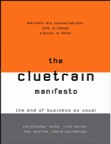The triggering event, of course, is the advent of a global communication
system that restores the banter of the bazaar,
that tears down power structures and senseless bureaucracies,
that puts everyone in touch with everyone.
From The Forward to the Cluetrain Manifesto
By Thomas Petzinger, Jr., The Wall Street Journal Author of The New Pioneers
Quotient or DNA? That’s the question.
If you have a Digital Quotient, you’ve learned most of your way through Microsoft Office, AOL, Hotmail or some other free email service and more than likely have your “tech guy” on speed dial. If you have Digital DNA, you probably had a MAC before Apple was chic, must have the latest gear and don’t need to flaunt it (you buy the plain black skin for it without a logo) and you can’t wait to get your sticky little fingers (from late night Twinkies, of course) on any new apps, programs, code, inside news, gossip AND your hacker’s on speed dial.

Somewhere in between is where I am. I had the first Apple laptop back in the early 1990’s, my favorite people are geeks and the digital references I make are over most people’s heads. Ok, so now that we’ve established that, there’s the matter of the digital divide. Still here and still thriving. I was around for the commercialization of the Internet and a thing called the “Cluetrain Manifesto“, written in 1999. That document was created, among other reasons, to inform marketers and advertisers that people using the Internet don’t want to be sold to. In short, as Thomas Petzinger, Jr., The Wall Street Journal put it, “an obituary of business as usual. ” And I quote:
The idea that business, at bottom, is fundamentally human.
That engineering remains second-rate without aesthetics.
That natural, human conversation is the true language of commerce.
That corporations work best when the people on the inside have the fullest contact possible with the people on the outside.
Fade out. Fade in. It’s the 2011, Ad Age Digital Conference here in New York City and the same principle applies. The conference is sold out and yet, the Keynote and other speakers, pretty much reiterate the same idea that those guys did. The difference is that marketers have to have their backs, or bucks, against the wall before they get the message.
This year’s conference was mostly about this. About staying out of the consumer’s way. About NOT selling but joining. About being a buddy (as in Media Buddy) and not a bully. About EXpression, not IMpression. The market place is changing so rapidly that we marketers and advertisers can’t consume the information about this change fast enough. As a sidebar, the year one Ad Age Digital conference had no sponsorship dollars at all. Now in only five years time, there are more than twenty. Presentations were delivered by such important companies as Google, Electronic Arts, Samsung, Lexus, Best Buy, Converse, Dell and more.
Aren’t We Always Rethinking Advertising?
First there were cave walls. Fast forward to print, radio, TV, satellite, digital etc etc. Each one of these innovations brings a retrench. Most professional marketers know this and still, there’s a lot of time and money spent measuring past results to predict future ones.

Social Activity (like communities, polls, Q&A, notifications, status, comments, games, group buying, virtual currency, social missions, social goods, check ins and the rest) is the largest consumption of time spent on the Internet today. To get marketers in the stream of activity means leaning forward like your customers are. This is activity, Folks, not media. Before activity was outside of advertising, now a marketer can leverage activity in the mainstream to have contact with 100 million people on a monthly basis to, say, help consumers build a virtual city.
Brand Lift Is The New Holy Grail.
Though corporations insist on seeing it as one,
the new marketplace is not necessarily a market at all.
To its inhabitants, it is primarily a place in which all
participants are audience to each other.
The entertainment is not packaged; it is intrinsic.
From Introduction to the Cluetrain Manifesto by Chrsotpher Locke
If you aren’t hip to this, sorry, but you’re already behind the eight ball. That is to say, if you’re still looking at click through rates as a measurement, forget it. If you’re still living in a world of display-click-impressions-banner ad next to content, the digital ecosystem has shifted to the next gear, the new way in which consumers view the brand. The flailing that research was doing while the ship was turning from past performance to real time left a lot of people, technological innovation and creative ideation mistakenly in its wake. Now, the tools for this have gotten a lot more sophisticated in a very short time. Companies like Point Roll and AppsSavvy would like to help you optimize your exposure. Marketers who are finally asking the right questions (not how big they are on ComScore and Nielsen and how many pages they have) but instead, “what are PEOPLE doing”, have a shot.
Friendster, Napster, MySpace, Facebook. What do they all have in common?
The answer is freedom. Each in its time carved a space for open discussion and sharing of ideas (creative branding or otherwise) Free space for anyone and anything to be highly energized by access and information like never before. In the old days, I was part of the Southern California (405) Group Listserve (remember those?) where a bunch of geeks, who rarely met face to face, discussed the Internet and problem solved collaboratively. It was not unusual for an entire thread to go on for weeks including barbs, open insults, challenges, put downs, throw downs and a ton of really cool information.
These were developers, inventors, code writers, thinkers, hackers and pioneers. One day a guy looking a lot like a Hells Angel rode his bike into our offices on Main Street in Venice (CA). We’d been talking to him virtually for months, but had no idea who he was standing there. He announced he was from Digital Vegas. We could never figure out how he got that Harley up to the third floor. But, I digress. The point is, no one was paying much attention except the other guys doing the same things. There was no regulation since no one but the government and educators even knew Arpanet was there. And certainly no one was trying to sell us stuff.
The Internet is inherently irreverent and anarchistic and therefore resists any attempt to wrangle or rope it in. It’s also a chance for people who would otherwise not meet to laugh and play and share trade secrets, whether the trade is Mommy-hood, bikers, hairdressers, dog lovers, cat lovers or just plain long-distance lovers.
The “C” or Connected generation, as Alex Tosolini, VP, Global e-Business at P&G, likes to call it, may or may not make way for today’s C-Suite Chief Data Scientist. When the advertiser insinuates himself into the conversation with waving banner ads and interstitials, the mob moves elsewhere. Social activity , the largest activity on the Web today, is, and I repeat, NOT media! Branding before this phenom was OUTside activity, now it’s INside. In effect, the herd will be heard whether marketers like it or not. It seems to have taken an entire decade and then some for marketers to realize this and having done so, loosen their grip. Like Double Click in the 1990’s with display, Tremor and other video networks and AdMob with mobile, companies like AppsSavvy, represented here, would like to help marketers brand around social activities and do it at scale.
“Everything That’s Static Will Become Dynamic.”

Words spoken by Wendy Clark, SVP-Integrated Marketing Communications and Capabilities at Coke. Of those most likely to win the respect of the mob, is Coca Cola, the world’s largest beverage company. Which is why, Ms. Clark refers to Coke’s digital strategy as “liquid and linked”. And that’s not just lingo. It’s Coke’s take on brand storytelling
Ms. Clark rips up the stage in a blinged-out Coke T-shirt lauding the virtues of the hundreds of opportunities to join in and be a partner in “distributed creativity” on a “continuum of connections”. Brands can no longer pay their way to greatness, she warned. Media isn’t categorized by the outlet you plug it into anymore, its either paid, earned, owned or shared, she said. Coke has actually become the poster child for doing it right and the online world has chosen to anoint them with a following.
The key, of course, is not some play on words or metaphor for a marketing strategy. It is the living breathing fact that Coke has given up control in the traditional marketing sense and taken the lead from it’s lovable fan base deferring to their voice, and not imposing on them Coke’s decades old sales strategy. Because of this, nearly 24.5 million people like Coke’s Facebook page, the largest page on the site. I guess when you serve 3 billion Coca Cola products worldwide every day, that doesn’t seem like such a big number. Yet, giving the ax to business-as-usual at a company this big, Ms. Clark had a lot to do when, in 2008, she moved over from AT&T. Coke didn’t start out with Digital DNA but, with Wendy Clark’s help, they sure did get IT along the way.
In 2008, UniLever discovered 50 representatives of the social online ecosystem (AKA Greenpeace) dressed as orangutans staging a protest outside their London Headquarters to highlight the destruction of the Indonesian rainforest. The protest forged a relationship between the two organizations with Unilever agreeing to address many of Greenpeace’s concerns. Unilever may not have started out life with Social Media DNA but they sure got religion fast.
Think Like a Start Up. Act Like a Hacker.
The Net grew and prospered largely because it was ignored.
It worked by different rules than the rules of business.
Market penetration wasn’t interesting because there was no market —
unless it was a market for new ideas.
The Cluetrain Manifesto – Chapter One, Internet Apocolypso
Massive disruptive change is a marketers worst nightmare. Just as Geoffrey Moore, head of the Chasm Group and author of Crossing The Chasm about technology adoption lifecycle, points out, “the marketer should focus on one group of customers at a time, using each group as a base for marketing to the next group.” The gap between them IS the chasm for disruptive or discontinuous innovations which force a significant change of behavior by the customer. In layman’s terms, climbing on the shoulders of early adopters is where the smart money is.
FaceBook, like other successful marketing plans that came before it, envisioned a need and filled it. Like is important, but Share is more important. Adopting a start up strategy may not get you where it got Mark Zuckerberg, but it might get you out of the dark or worse, the Dark Ages. Build a virtual startup within your organization to imitate what it was like when everyone was bootstrapping and no one was watching. Teams of geniuses were liberated from the matrix and finding the next thing rather than protecting the old. The team not connected to the parent, innovates, iterates rapidly on its own and builds on user experience, skills, talent, not titles. Android, a Google offshoot, while in the search business, was simultaneouslyfree from the core and faithful to Google’s devices. Today, it’s the next BIG thing.
To Ride The Trend Wave-
Make it Low Cost
Launch and Learn
Take the Best Ideas From Everyone Else
Fast Is Better Than Perfect
VOCAB OF THE MODERN MARKETPLACE
Apple Generation, C-generation,
Social Online Ecosystem, Lean in, Honor the Community,
Passion Points, Connections Are The New Impressions,
Facilitate Commerce, Hardworking Media,
Networked Consumption, A Lense on Social Media,
Listenomics, Digital Skin, Digital Cocktailing,
Start Up Envy, Native (to a medium), Path to Purchase,
Continuum of Connections, Distributed Creativity
